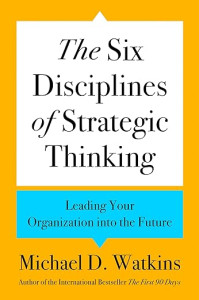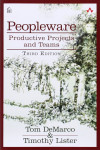The six disciplines of strategic thinking
Leading Your Organization into the Future
"The Six Disciplines of Strategic Thinking" presents a structured approach to developing the mental capabilities needed for effective leadership in today's complex business landscape. Watkins identifies and explores six interconnected cognitive disciplines that enable leaders to navigate volatility, uncertainty, complexity, and ambiguity while steering their organizations toward sustainable success.
The book breaks down strategic thinking into tangible skills that can be learned and practiced: pattern recognition for identifying threats and opportunities; systems analysis for understanding complex environments; mental agility for adapting to changing circumstances; structured problem-solving for addressing challenges systematically; visioning for creating compelling future states; and political savvy for building essential alliances.
Unlike many strategy books that focus primarily on planning processes, Watkins emphasizes the cognitive foundations that underpin strategic excellence. Through practical frameworks and real-world examples, he demonstrates how these disciplines work together to improve decision-making, foster innovation, and align organizational efforts toward meaningful goals.
The approach is particularly relevant for leaders navigating digital transformation, market disruption, and organizational change, providing them with tools to translate complex challenges into actionable strategic direction.
By reading The Six Disciplines of Strategic Thinking, you will:
- Master pattern recognition techniques to identify emerging threats and opportunities: Learn to spot significant trends and separate signal from noise in complex business environments, enabling faster and more accurate strategic responses.
- Develop systems thinking to understand complex organizational dynamics: Build mental models that capture how different components of your business interact, helping you identify leverage points and avoid unintended consequences of strategic decisions.
- Enhance your mental agility to navigate uncertainty and change: Practice shifting between different levels of analysis and anticipating competitive responses, allowing you to adapt strategies quickly when circumstances change.
- Implement structured approaches to problem formulation and solution: Learn systematic methods for framing challenges, generating creative solutions, and making difficult strategic choices with greater confidence and clarity.
- Craft compelling visions that motivate and align your organization: Develop skills for imagining achievable yet ambitious futures and communicating them in ways that inspire commitment and coordinated action.
Books to Follow
- "Playing to Win: How Strategy Really Works" by A.G. Lafley and Roger L. Martin: Complements the six disciplines with a practical framework for strategy development and execution, focusing on where to play and how to win.
- "Thinking in Systems: A Primer" by Donella H. Meadows: Expands on the systems analysis discipline with deeper exploration of systems thinking principles, feedback loops, and leverage points.
- "The Fifth Discipline" by Peter Senge: Provides extensive coverage of systems thinking and organizational learning, building on the adaptive organization concepts introduced in the systems analysis discipline.
- "Good Strategy/Bad Strategy" by Richard Rumelt: Offers complementary perspectives on structured problem solving and diagnosis-based approaches to strategy formulation.
- "Seeing Around Corners" by Rita McGrath: Extends pattern recognition concepts by focusing on how to spot inflection points before they become obvious to competitors.
Pattern Recognition
Strategic leaders develop the ability to identify meaningful patterns and signals amidst complex information environments. This involves recognizing critical trends, separating signal from noise, and understanding the implications of emerging developments. Leaders can improve this skill through immersion in their industry, studying case examples, and deliberately practicing the RPM cycle (Recognize, Prioritize, Mobilize) when responding to new information.
Systems Analysis
Effective strategic thinking requires understanding organizations as complex systems with interconnected elements rather than isolated components. By creating mental models of these systems, leaders can identify leverage points where small changes yield significant results, anticipate unintended consequences, and design more effective interventions. This approach helps leaders move beyond simplistic cause-effect thinking to understand dynamic relationships and feedback loops.
Mental Agility
Strategic leaders develop the ability to shift between different levels of analysis and anticipate others’ responses to their actions. This “cloud-to-ground” thinking allows them to connect high-level strategy with operational reality while understanding competitive dynamics. Techniques like scenario planning and game theory help leaders prepare for different possibilities rather than being caught off guard by unexpected developments.
Structured Problem Solving
Rather than jumping to solutions, strategic thinkers follow a disciplined approach to problem-solving: defining roles, framing problems properly, exploring multiple solution options, making decisions based on clear criteria, and committing to action. This systematic process improves decision quality by ensuring problems are properly understood before solutions are developed.
Visioning
Creating an ambitious yet achievable vision of the future energizes organizations and aligns efforts. Effective visions go beyond generic statements to provide specific, meaningful descriptions of a desired future state that stretches the organization while remaining achievable. Leaders communicate these visions through powerful simplification and storytelling techniques that connect emotionally with diverse stakeholders.
Political Savvy
Strategic implementation requires understanding organizational politics and building supportive coalitions. This involves mapping influence networks, understanding stakeholders’ interests, and using appropriate influence tactics. Rather than viewing politics negatively, strategic leaders recognize it as an essential aspect of organizational life that must be navigated to achieve meaningful change.
VUCA Navigation
Strategic thinking provides tools for navigating environments characterized by Volatility, Uncertainty, Complexity, and Ambiguity (VUCA). Each discipline contributes to handling these challenges: pattern recognition helps identify important developments; systems analysis addresses complexity; mental agility navigates uncertainty; structured problem-solving handles ambiguity; visioning provides direction amid volatility; and political savvy builds alignment in dynamic environments.
Q: How does strategic thinking differ from strategic planning?
A: Strategic thinking is the cognitive work leaders do to make sense of complex situations and frame sound direction. Strategic planning is the formal exercise of laying out goals, timelines, and actions. When thinking is weak, the planning that follows often turns into a list of hopeful targets rather than a course of action grounded in insight.
Q: Why group the ideas into six disciplines instead of mastering a single skill?
A: Complex challenges require several abilities working together—seeing patterns, understanding systems, choosing among options, inspiring people, and building support. Focusing on only one leaves blind spots (for instance, strong analysis without the influence skills to act on it). The six-part model keeps the skill set balanced.
Q: Which discipline should I develop first?
A: Begin with pattern recognition and systems analysis. They help you read the external environment and grasp how your organisation works as a whole. If you already have strength there, pick the discipline where you are least confident—closing the biggest gap yields the fastest overall improvement.
Q: How is pattern recognition different from data analytics?
A: Analytics surface correlations; pattern recognition adds context and judgement, deciding which signals matter, what they mean, and when to act. The two work best together—data informs the patterns you notice, and good judgement stops you chasing every statistical blip.
Q: What makes a systems model “good”?
A: A useful model captures the essential parts, their feedback loops, and the purpose of the system—no more, no less. It should be easy to update as conditions change and point clearly to the spots where small interventions create outsized impact.
Q: How can I practise these disciplines day-to-day?
A:
- Weekly horizon scan: Block time to scan industry news and spot emerging patterns.
- System maps: Sketch how inputs, activities, and outcomes link together for a current challenge.
- Pre-mortems: Imagine a decision failing and list what caused it; this sharpens mental agility
- Structured problem solving: Work through define → frame → explore → decide → commit for major issues.
- Vision moments: Describe the desired future in different settings—emails, stand-ups, one-on-ones.
- Stakeholder mapping: Chart who influences a project and plan how to involve each person early.
- Deliberate, repeated use turns these actions into reflexes.
Q: Can teams learn the disciplines, or are they purely individual?
A: Teams can and should learn them together. Group pattern-spotting sessions, shared system maps, collaborative scenario workshops, and collective visioning build a common language and raise the strategic capability of everyone involved.
Q: How do I balance strategic thinking with pressure for quick results?
A: Fold the disciplines into normal work rhythms. Start each morning with a brief pattern scan; use systems thinking to pick high-impact tasks that help both short- and long-term goals; apply the structured problem-solving flow to urgent issues; check that day-to-day decisions align with your stated vision; and use political savvy to protect focus when distractions appear. Doing so improves execution because effort stays anchored to what matters.
Q: How does this apply to technical roles such as product management?
A: Product managers use pattern recognition to spot shifts in customer needs, systems thinking to understand how features affect behaviour and revenue, mental agility to anticipate competitor moves, structured problem solving to prioritise the roadmap, visioning to tell a compelling product story, and political savvy to work across functions. These skills separate strategic product leaders from backlog administrators.
Q: What is the link between strategic thinking and innovation?
A: Strategic thinking directs innovation toward worthwhile opportunities. Patterns reveal emerging possibilities, systems thinking shows where change will matter most, mental agility encourages fresh angles, structured problem solving frames the challenge, visioning gives innovation a destination, and political savvy secures resources. Without this foundation, creative ideas risk being unfocused or disconnected from real needs.
Q: How do I practise political savvy without feeling manipulative?
A: View influence as surfacing interests early and finding overlap. Spend time listening, frame proposals in terms that address others’ concerns, and sequence conversations so people are never surprised. Openness and respect build the coalitions you need without hidden agendas.
Q: What first step should I take after finishing the book?
A: Pick a current project and run it through the five-phase problem-solving flow. Note where pattern recognition, system understanding, and influence are strong or weak, then set one concrete improvement action for each weak spot. Small wins build momentum for deeper practice.
- When transitioning to a leadership role with strategic responsibilities: You need to shift from tactical execution to longer-term thinking and organizational direction-setting. The book provides a comprehensive framework for developing the mental skills needed for this transition.
- During periods of significant industry disruption or market change: You’re facing increased competitive pressure, technological shifts, or market volatility. The book helps you develop the pattern recognition and mental agility needed to navigate uncertainty and identify emerging opportunities.
- When leading organizational transformation efforts: You’re responsible for guiding significant change within your organization. The book’s systems thinking and visioning disciplines provide tools for understanding complex organizational dynamics and creating compelling future states.
- When struggling to balance immediate pressures with long-term direction: You find yourself constantly reacting to urgent issues rather than proactively shaping the future. The book offers structured approaches to balance operational demands with strategic thinking.

Your support helps me maintain and improve the book recommendations for everyone.









